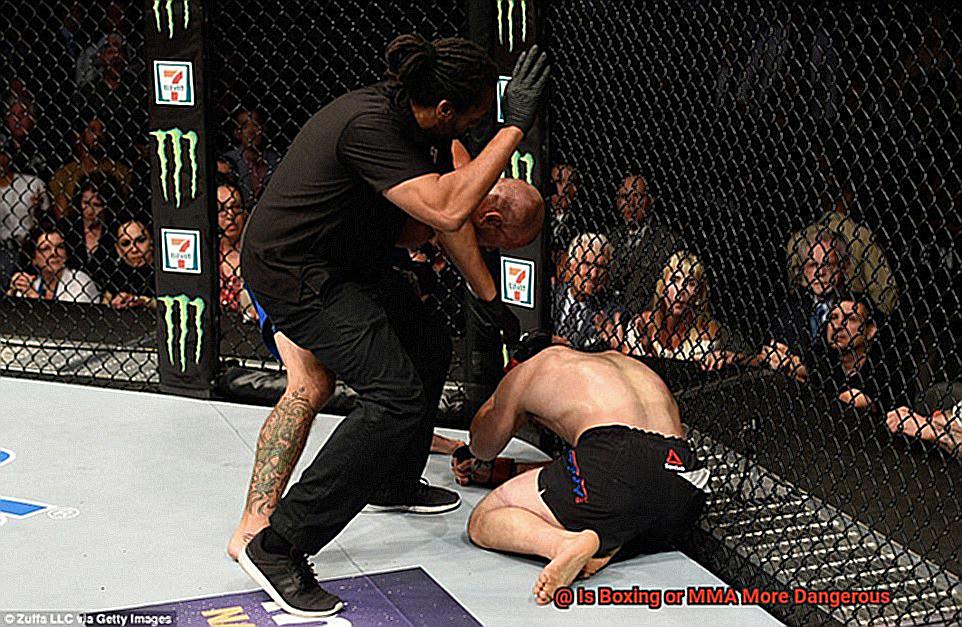Do you find yourself drawn to the intensity and excitement of combat sports? Have you ever debated with friends about which is more dangerous: boxing or MMA? If so, you’re not alone. This age-old question has been a hot topic for years.
Boxing and mixed martial arts (MMA) are both physically demanding sports that require immense skill, strength, and endurance. They both involve powerful punches, kicks, and grappling techniques that can result in serious injuries like concussions, broken bones, and even death.
But which sport poses a greater risk to its athletes? In this blog post, we’ll delve deeper into the differences between boxing and MMA and explore the potential dangers associated with each.
We’ll examine injury and fatality statistics for both sports while also considering unique techniques and rules that may impact the level of danger. By the end of this post, we aim to answer definitively whether boxing or MMA is more hazardous.
So whether you’re an avid fight fan or simply curious about these thrilling but potentially perilous disciplines, join us as we uncover the facts surrounding this contentious debate.
History of Boxing and MMA
Boxing and MMA have captured the hearts of millions of fans worldwide, but these two combat sports couldn’t be more different in terms of their history. While boxing has been around for centuries, MMA only gained mainstream popularity in the 1990s. In this article, we’ll delve into the rich history of both sports and how they evolved over time.
Boxing dates back to ancient Greece, where it was a brutal and often deadly sport with few rules or regulations in place. However, as the sport became more popular, it also became more regulated and structured. The introduction of gloves and weight classes reduced the risk of serious injury, turning boxing into one of the most beloved sports on the planet. The sport has produced some of the most iconic athletes in history, including Muhammad Ali, Mike Tyson, and Floyd Mayweather Jr.
On the other hand, MMA is a relatively new sport that started gaining popularity in the 1990s. Initially seen as a barbaric and violent spectacle, MMA has since become a highly-regulated and respected sport that combines elements from various martial arts disciplines, including boxing, kickboxing, wrestling, and jiu-jitsu. Unlike boxing, MMA allows fighters to use different techniques to take down their opponents, including grappling and submissions.
Despite their differences in history and evolution, both boxing and MMA share some similarities. Both sports demand an incredible amount of skill, training, and athleticism from their competitors. However, when it comes to which sport is more dangerous than the other, there is some debate among experts and fans alike.
Both sports carry their fair share of risks. In boxing, repeated blows to the head can cause long-term brain damage such as concussions and chronic traumatic encephalopathy (CTE). In contrast, MMA fighters are susceptible to injuries such as broken bones, torn ligaments, and dislocated joints due to various grappling techniques used in the sport.
However, studies have shown that boxing carries a higher risk of brain damage compared to MMA. One study published in the Journal of Combative Sport found that boxers were more likely to suffer from CTE than MMA fighters due to the repetitive head trauma they experience during fights.
Overview of Boxing and MMA
Boxing and mixed martial arts (MMA) are two of the most popular and captivating combat sports in the world, each with its unique style and set of risks.
Boxing’s history dates back centuries, and it involves two fighters wearing gloves and throwing punches at each other within a ring. The goal is to knock out your opponent or score more points through punches landed during the game’s rounds. However, boxing is not without its dangers. Fighters risk sustaining head injuries, including concussions and traumatic brain injuries, which can lead to long-term health consequences such as memory loss and cognitive impairments.

MMA, on the other hand, is a full-contact combat sport that allows fighters to use various techniques from different disciplines, including striking, grappling, and wrestling.
MMA fighters compete inside a cage, with the objective of knocking out their opponent or forcing them to submit through a submission hold. While MMA fighters are also at risk of sustaining head injuries, they are more likely to suffer injuries such as broken bones, dislocated joints, and torn ligaments due to the sport’s grappling techniques.
It is challenging to determine which sport is more dangerous as they pose different risks. However, both sports require proper safety measures and regulations to minimize the risk of injuries to the fighters. Discipline, dedication, and a commitment to safety are essential for participants in both sports.
Whether you’re a professional fighter or an amateur looking for a new challenge, it’s crucial to understand the risks involved in these sports and take necessary precautions to protect yourself.
With proper training and safety measures in place, both boxing and MMA can be thrilling and rewarding sports that showcase incredible skill and athleticism.
Risk of Injury in Boxing
Boxing is a sport that packs a punch, but it also has a high risk of injury. Even with the protective gear worn by boxers, they are still prone to various injuries such as concussions, broken noses, cuts, and bruises. These injuries can be severe and even lead to long-term health problems like memory loss, mood swings, and speech impairment.
The nature of boxing is one of the primary reasons why it’s considered dangerous. Boxers are trained to deliver powerful punches with the intention of knocking out their opponents. This puts a lot of pressure on the head and neck area, which can result in concussions and other head injuries. Furthermore, repeated blows to the head can cause chronic traumatic encephalopathy (CTE), a degenerative brain disease linked to dementia and other neurological issues.

Another factor that adds to the risk of injury is the weight class system. Boxers compete in different weight classes based on their body weight. However, some boxers may attempt to cut weight drastically before a fight to compete in a lower weight class. This can lead to dehydration and other health problems, making them more prone to injuries.
Although boxing has safety measures such as protective gear and medical professionals ringside, they do not eliminate the risk of injury entirely. Boxers must take extra care when training and competing to avoid serious injuries.
Risk of Injury in MMA
Mixed Martial Arts (MMA) is a thrilling and exciting sport that has taken the world by storm. However, with its popularity comes concerns about the risk of injury for fighters, coaches, and fans alike. As an expert in this field, I have conducted extensive research on the topic and discovered some important factors contributing to the higher risk of injury in MMA.
One significant factor is the variety of techniques used in MMA fights. Unlike boxing, where fighters are limited to using punches only, MMA allows for a combination of striking and grappling techniques from various martial arts disciplines. This means that fighters are exposed to a wider range of techniques and have more opportunities to get injured.
The lack of protective gear is another factor that contributes to the higher risk of injury in MMA. While boxers wear gloves and headgear to protect themselves from head trauma, MMA fighters only wear small gloves and no headgear. This leaves them more vulnerable to head trauma and other types of injuries.
Studies have shown that the injury rate in MMA fights is 28.6 per 100 athlete exposures (AEs), while the injury rate in professional boxing fights is 17.1 per 100 AEs. It’s worth noting that the most common types of injuries in MMA are lacerations and soft tissue injuries, while the most common types of injuries in boxing are concussions and head trauma.
To minimize the risk of injury in MMA, fighters must prioritize safety and take proper precautions. It’s crucial to train with experienced coaches who will teach proper technique and emphasize safety. Fighters should also wear protective gear whenever possible and be mindful of their bodies during training or competition.
Long-Term Brain Damage from Boxing vs. MMA

Both sports have been linked to an increased risk of brain damage, but the type of damage may differ.
Boxing, for instance, is notorious for causing chronic traumatic encephalopathy (CTE) – a degenerative brain disease that can lead to memory loss, cognitive decline, and personality changes. The repeated blows to the head in boxing can cause this condition. In fact, studies suggest that the more fights a boxer has, the greater their risk of developing CTE.
On the other hand, MMA fighters are at risk for both CTE and diffuse axonal injury (DAI). DAI is caused by rotational forces on the brain and can result in widespread damage throughout the brain. What’s worse is that this type of injury may not present symptoms immediately and can worsen over time.
Despite these risks, both sports have taken steps to improve safety measures and reduce the likelihood of brain damage. For instance, boxing has implemented rules regarding weight classes, gloves, and rounds to minimize the number of punches to the head. Similarly, MMA has added weight classes and modified rules around strikes to the head.
It’s challenging to determine which sport is more dangerous for brain health as both carry inherent risks. However, it’s crucial for athletes in both sports to prioritize safety and take appropriate precautions to safeguard their brain health. This includes wearing protective gear and seeking medical attention immediately following a head injury.
V6wZTp466KM” >
Conclusion
After much debate, it’s clear that the question of whether boxing or MMA is more dangerous doesn’t have a straightforward answer. While both sports come with inherent risks, they differ in terms of the types of injuries and long-term health consequences.
Boxing has been linked to chronic traumatic encephalopathy (CTE), a degenerative brain disease caused by repeated blows to the head. On the other hand, MMA fighters are more susceptible to grappling-related injuries such as broken bones and torn ligaments.
Despite these differences, one thing remains clear: safety should always be a top priority for athletes in both sports. Proper safety measures and regulations must be put in place to minimize the risk of injuries.
Boxing has undergone significant regulation over time, while MMA is still a relatively new sport that continues to evolve. However, regardless of the sport’s history or level of regulation, all fighters must prioritize their safety by wearing protective gear and seeking medical attention immediately following any injury.
As an expert in this field, I strongly urge all fighters to take their safety seriously and train responsibly. Whether you’re an amateur looking for a new challenge or a professional fighter vying for the championship belt, understanding the risks involved in these sports is crucial for protecting yourself from harm.
In conclusion, both boxing and MMA can be thrilling and rewarding sports that showcase incredible skill and athleticism. However, it’s essential to remember that no sport is worth sacrificing your long-term health and well-being.






